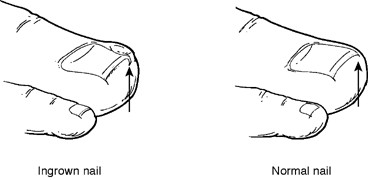What is ingrown toenail?
It is a curved nail that grows into the skin, usually at the nail borders (the sides of the nail). This “digging in” of the nail irritates the skin, often creating pain, redness, swelling, and warmth in the toe.
An ingrown nail may break in the skin causing a bacterial infection which is often marked by drainage and a foul odour.
Causes
- Heredity: In many people, the tendency for ingrown toenails is inherited.
- Curved nail bed
- Trauma: Sometimes an ingrown toenail is the result of trauma, such as stubbing your toe, having an object fall on your toe, or engaging in activities that involve repeated pressure on the toes, such as kicking or running.
- Improper trimming: The most common cause of ingrown toenails is cutting your nails too short. This encourages the skin next to the nail to fold over the nail.
- Ill-fitting footwear: Ingrown toenails can result from wearing socks and shoes that are tight or short.
- Nail Conditions: Ingrown toenails can be caused by nail problems, such as fungal infections or losing a nail due to trauma.

Conservative treatments
- Soak the foot in warm water 3-4 times daily.
- Keep the foot dry during the rest of the day.
- Wear comfortable shoes with adequate room for the toes. Consider wearing sandals until the condition clears up.
- Visit a podiatrist regularly
Surgical Treatments
Sometimes a minor surgical procedure, often performed in the office, will ease the pain and remove the offending nail. After applying a local anaesthetic, we remove part of the nail’s side border and cauterise nail matrix using Phenol.
If there are too much hyper granulation tissues, sharp nail resection may be required.
Following the nail procedure, a light bandage will be applied. Most people experience very little pain after surgery and may resume normal activity the next day. If an oral antibiotic is prescribed, be sure to take all the medication, even if your symptoms have improved.


